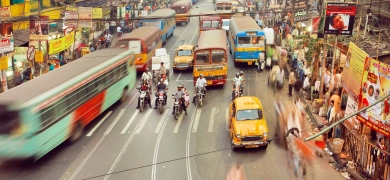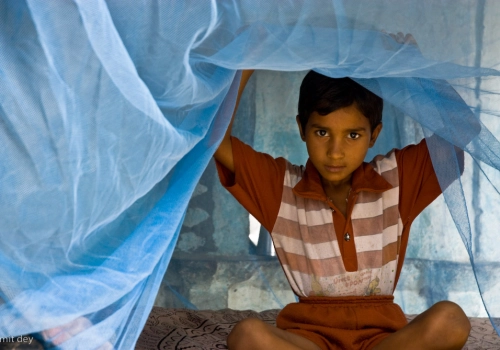Odisha’s triumph over malaria
The game-changing impact of long-lasting insecticidal nets

19 August 2024
Category:
Country perspectives and lived experienceTransforming malaria prevention in India’s most affected state
In 2016, despite accounting for only 4% of India’s population, Odisha accounted for nearly half of the nation’s malaria cases. This staggering statistic was largely due to residents working in dense forests without adequate protection, leaving them highly susceptible to mosquito-borne diseases. Compounding the crisis were the widespread misuse of bed nets, the practice of sleeping outdoors, and the unsettling development of mosquito resistance to three of four WHO-recommended classes of insecticides. This alarming scenario underscored the critical need for urgent and effective interventions. In response, the strategic deployment and use of long-lasting insecticidal nets emerged as a transformative solution, dramatically reshaping the landscape of malaria control in Odisha, India’s highest malaria-burden state.
Significant reduction in malaria cases
Within 5 years, a coordinated and focused government intervention, mobilization of local and community networks, and holistic prevention and treatment programmes would result in a 90% reduction in malaria cases and an 89% reduction in malaria deaths.
Malaria cases across India decreased by more than 40% in the same period, a remarkable achievement that demonstrates how malaria cases and deaths can be drastically reduced through coordinated intervention and effective deployment of insecticidal mosquito nets.
A national framework for malaria elimination
The Government of India introduced its National Framework for Malaria Elimination (NFME) in 2016 with two main goals: to eliminate malaria throughout the country by 2030 and maintain malaria-free status. Embracing the World Health Organization's "high-burden, high-impact" approach – focusing on high transmission areas like Odisha – would be critical to success.
Scaling up bed net distribution
India’s malaria control strategy focused on the distribution of mosquito nets, indoor residual spraying, expanding the use of diagnostic tests and providing early treatment for malaria cases. In 2017, the Government significantly scaled up the distribution of bed nets. With financing from the Global Fund, approximately 11 million bed nets were distributed in Odisha in 2017, 4.5 million of which were PermaNet® 2.0. Between 2017 and 2018, Odisha saw an 80% reduction in malaria cases.

Community involvement and education
Odisha’s successful prevention and treatment strategies were underpinned by strong political will and mobilization of resources. Dr Kaushik Sarkar, Director at the Institute for Health Modelling and Climate Solutions at Malaria No More and advisor to the DAMaN project in Odisha, explains:
“In Odisha, beyond the support provided by the Government of India, there was also a very high level of state commitment and political will to mobilize resources, which contributed substantially to the success. Strategic support to the government was provided by organizations like Malaria No More. We advised on targeted interventions at the state and district level, appropriate areas of focus, and mobilization of resources with organizations like Vestergaard, Abbott, UNICEF, and many others who supported us in our endeavour.”
Overcoming implementation challenges
A holistic approach to prevention and treatment, considering local contexts, mobilizing communities and incorporating effective social and behavioural change campaigns, yielded excellent results.
900,000 trained Accredited Social Health Activists (ASHAs) spearheaded the distribution of mosquito nets and were present in every village across the hilly state, serving as health activists, educators, and promoters. ASHAs taught communities about the life-saving protection of mosquito nets and the correct ways to use them. In some villages, the state also enlisted folk troupes who travelled from village to village to perform and communicate the basics of malaria control. Health workers drove vans equipped with loudspeakers to broadcast messages and distribute pamphlets.
“Once nets are distributed, at the grassroots level, some people might not use them for a variety of reasons, including cultural ones,” explained Dr Kaushik Sarkar.
“Men sometimes do not want to carry them when going to work in the forest, and some don’t want to use them when sleeping outdoors in hot, humid, tropical weather. Nets are not always used properly and are washed and dried in the wrong manner."
To overcome these challenges, ASHAs sensitized community leaders, conducted nightly monitoring to ensure that nets were fitted properly, provided demonstrations of how the nets should be used and washed, and rang a warning bell at night to remind people to put up the nets.
The distribution of insecticidal nets with a 3-year / 20-wash lifespan to communities that had not received nets for many years was critical. This factor, alongside the large-scale distribution, provided a preventive umbrella across the state.
Malaria No More conducted an attitude survey across 17 high malaria-endemic districts, which showed that the social and behavioural campaign achieved a high level of mosquito net use.
However, more still needed to be done to reach the less accessible areas of the state where routine programmes consisting of umbrella healthcare provided by ASHAs were insufficient. In some areas, ASHAs would have to travel distances as long as 13 kilometres, crossing forests and rivers, creating barriers to accessibility and security.
Furthermore, some people were unaware of the role of ASHAs, instead seeking traditional healers or unqualified practitioners. In high malaria-endemic areas, asymptomatic—and thus usually undiagnosed—malaria cases present a further challenge.
Innovative strategies: malaria camps
So, a further strategy was adopted: “malaria camps”, otherwise known as DAMaN Durgama Anchalare Malaria Nirakaran’ (malaria elimination in less accessible areas).
Malaria camps can be more effective in diagnosing and treating people in high transmission areas compared with routine programmes. These camps occur two to three times a year, once before the monsoon and once after. They are based on three basic principles: mass screening of populations aimed at the simultaneous elimination of all malaria parasites, treating all positive cases, irrespective of symptoms, and reducing the population of vector-borne mosquitoes through measures such as mosquito nets and indoor residual spraying. ASHAs visit the villages to provide these key interventions, along with education and maternal and child health visits.
Dr Kaushik Sarkar explains: “We needed to strengthen the essential services like the drugs and diagnostics at the last mile. That’s why the camp-based approach proved so effective.”
National and global efforts to sustain success
The Government of India is seeking to replicate the success in Odisha by launching national campaigns, mobilizing expanded domestic and global resources, and building coalitions and partnerships. Malaria No More, with its network of advisors and partners, is providing strategic support.
Educational and behavioural campaigns are becoming increasingly important with the growing threat of temperature increase in the Himalayan region. In Odisha, extreme weather events like storms and cyclones are becoming commonplace. The India Intelligence Expert Committee on Malaria and Climate raised the concern that with erratic rainfalls and flash flooding creating new bodies of water, new areas are becoming receptive to malaria. People who have never experienced malaria and have limited or no knowledge of malaria prevention and treatment could come into contact with the disease.
Continued challenges and future directions

In 2019, the Government of India increased funding by more than 25% for the National Vector Borne Disease Control Programme and increased support as a donor to the Global Fund.
The effects are clear—according to World Malaria Report 2023, the number of cases and deaths due to malaria in India has continued to decline. With an estimated 3.4 million cases and 5,511 deaths, India saw a decrease of 30% in malaria incidence and 34% in mortality in 2022, compared with the previous year. The malaria camp model continues to operate in Odisha, where cases continued to decline consistently up to 2022 by around 90%—from 450,000 to 25,000.
However, more recently, there are signals that if mosquito net delivery intensity slackens, progress could be threatened. According to the National Centre for Vector Borne Diseases Control, malaria cases in Odisha almost doubled in 2023 compared to 2022. In 2023, Odisha once again had the highest number of malaria cases in India (41,971) and four deaths, showing that sustaining efforts is crucial to reaching elimination goals.
“India has made a huge success in terms of reducing malaria, and I would say it is on track to achieving the 2030 elimination goal. In India, there are pockets where socio-economic and geophysical access is a problem. In those areas, you cannot reach elimination without a focus on holistic development. I think the Government is taking steps towards this through the NITI Aayog programmes, which target the 112 most under-developed districts nationwide. Measures like vaccines or spatial repellents can be used as additional or supplementary measures. Still, it cannot ever replace the routine of traditional interventions like indoor residual spraying or bed nets, which function as a barrier between the man and the mosquito and are a very critical tool at the last mile of elimination,” said Dr Kaushik Sarkar.